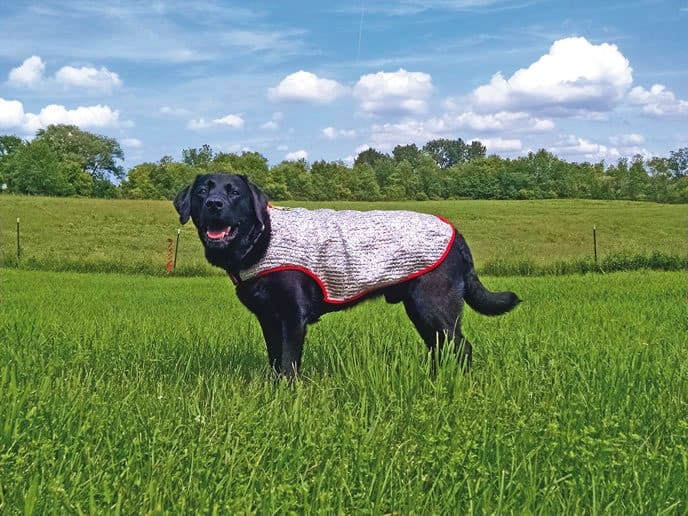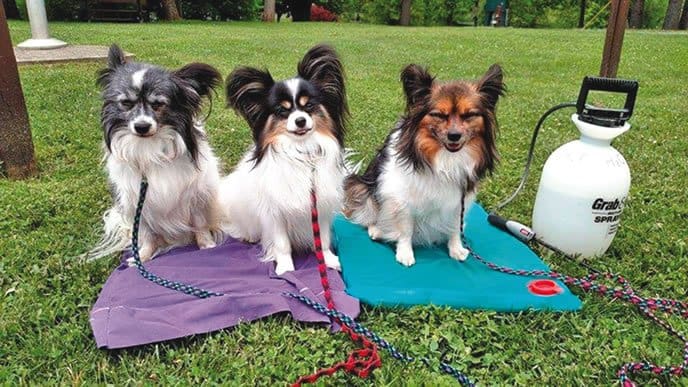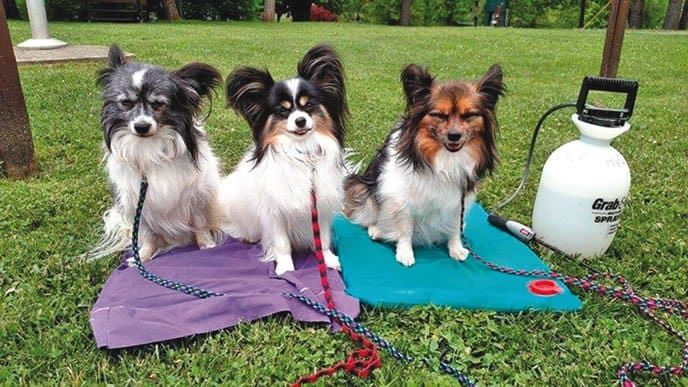A dog’s primary means of cooling himself is through panting – and our goal is to make this process more efficient.
When a dog pants, air flows over the tongue and throat area and helps cool the blood sent to the tongue by the heart. That cooler blood then circulates through the rest of the body back to the heart, to start the process over.
The harder a dog’s working to stay cool, the bigger his tongue becomes in an effort to maximize that air circulation. That’s why a wide, red tongue indicates a dog is working hard at keeping his body cool.
However, as the temperature and humidity rise, the inefficiency of this system becomes apparent. The warmer it is outside, the warmer the air is that the dog takes into his body. When ambient temperatures become close to a dog’s normal body temperature, the system begins to fail.
While most dogs begin getting warm around the 80°F mark (depending on humidity), the out-of-shape dog may be stressed at much lower temperatures. Clearly, as the outside air temperature rises and gets closer to the dog’s body temperature, the effectiveness of panting decreases. A dog in warm weather needs your attention to avoid potentially deadly heat stroke.
To help avoid this, consider your dog’s condition. Keeping your dog well groomed, physically fit, and at his optimal weight will help him avoid suffering from heat stress. Just as in humans, too much fat and not enough exercise result in a decreased level of heat resistance. And, the more he pants, the more water he’ll need to consume – the cooler, the better.
But even fit dogs may need you to enforce limits during hot weather. “I try to acclimate them to exercising in warm weather so they can handle it at a trial, but if it’s extremely hot out, we will just stay home in our air-conditioned house!” says Linda Aloi, owner of K9 Capers Dog School in Baldwinsville, New York.
Some active dogs have been known to exercise to excess, causing major physical heat-related damage to themselves and possibly death. If you are playing fetch and your dog is barking at you to “Throw the ball again! Throw the ball again!” – but you notice his speed has decreased when running after the ball and returning to you – he’s probably had enough.
– Some of the most common causes of heat stress are:
– Being muzzled in a warm environment
– Leaving the dog in a car during warm weather (even in the shade or with windows cracked open); or leaving a dog in a hot room or garage with insufficient air flow
– Excessive exercise, or exercise in extreme temperatures
– Travel over hot pavement/concrete surfaces
– Lack of shade and/or fresh water
Keep That Coat On
Your dog’s coat is designed to protect him from weather extremes. Regular grooming is a necessity, especially for dogs with a thick undercoat, like Shetland Sheepdogs, Pomeranians, and Labradors. That hair needs to be fluffy to do its insulation job, so if it’s matted or dirty, get out the grooming equipment. Dogs who appear to have thick tufts of uneven hair throughout their coat definitely need the old undercoat brushed out. Single-coated dogs – think Papillons, Poodles, and Weimaraners – can actually be at a disadvantage. They may need more protection against sunburn and heat because they lack that protective undercoat.
Whatever you do, avoid the myth about shaving your dog’s coat to make him cooler. “Never shave down a double-coated breed,” says Mary Jo Johnson, an agility instructor Farmington, New York, who competes with her Shetland Sheepdogs. “It may seem counterintuitive, but that undercoat is a good thing.”
There are exceptions to the no-shave rule, of course. Hot spots and other dermatological issues may require spot shaving for treatment. Some dogs may need spots shaved for breed standards or cleanliness. Also, strategic shaving in specific areas (as opposed to shaving the whole dog) can help with the cooling process, especially in canine athletes. “I actually will clip the hair in the summer in the groin area, so my dogs can lie down in the baby pool and the water can reach that skin,” Johnson says, “but only the groin area.”
Keep Your Dogs Hydrated
At home, many dogs enjoy playing or lying down in a hard plastic kiddie pool containing a few inches of fresh, cool water. This is a much easier way to wet down your dog to cool him off than a hose.
“When I wet down my dog in a pool, I wet the belly, groin area, and under the ‘armpits’ of the front legs,” says Diane Eggleston, owner of Awesome Abilities Dog Training School in Skaneateles, New York. “You should not wet their backs because it can actually make them hotter,” as it can trap the heat closer to the skin.
A simple spritz with a sprayer might do the trick for many dogs. If Eggleston is away from home, she carries a sprayer with a mix of water and a little coat conditioner to help cool her dogs. “I use the type of sprayer used to spray weeds,” she says. “I use it to the wet the belly areas, like I do in the pool.” Of course, this sprayer should be designated and labeled for dog use only.
Make sure your dog always has fresh, cool water for your dog. On especially hot days, toss a few ice cubes in the water. You can also make an inexpensive treat by mixing water with some broth, freezing it in ice trays, and giving the cubes to him in a bowl. Don’t add these to his water, however; your dog needs constant access to plain water.
If you’re going for a walk or hike in hot weather, always carry along water and a bowl for your dog.
Shady solution
If your dog is going to be outside with you for an extended period – say, at your daughter’s soccer match – he’ll need shade, especially if he has a dark coat. A pop-up tent or umbrella can provide enough instant shade to really help.
People who attend outdoor dog shows or canine athletic events with their dogs almost always bring shade tents, plus sun shields that can be draped over a dog’s wire or soft-sided crate, to provide extra shade without impairing air flow.
Clean Run, the agility catalog and store, offers a great product called the Cool Puppy Shade Cloth Panel, made of a knitted, reflective aluminized fabric. Draped over a wire crate or exercise pen, it reflects the sun’s rays but doesn’t stop air flow. Clean Run estimates the result is a spot that is cooler by as much as 14°F and we would agree. The panels are available in a variety of sizes, from $45 for a 7′ by 6′ panel, up to a 14′ x 10′ panel for $108.

Cooling Aids
Fans get a big “two paws up” from most dogs. Portable fans, especially those designed for camping, run off of batteries. Most dogs will seek out the cool breeze and lie down right in front of the fans to keep cool. “At agility trials, my dogs are kept cool with a shade tent and fans. I also have gel cool mats for them to lie on,” Johnson says. These fans are available at most major hardware and discount department stores, like Walmart.
Commercial cooling mats or beds are based on a dog’s natural instinct to dig dirt holes during the summer; they give your dog a cool resting spot. You can also use a wet beach towel on the floor or ground. Frequently refreshed, clean and placed out of the sun, a wet towel can give your dog a cool spot to lie down, even on the kitchen floor. (Of course, the humans in the household will need to be careful not to step on it and slip!)
Many commercial cooling beds are filled with a gel designed to absorb the dog’s body heat. Some beds are filled with water that circulates heat away from the dog.
You can make your own ice-pack bed, too. When I attend a summer agility trial, I pack an equine leg bandage that’s been soaked in water and then frozen. It’s the perfect size for my Papillons to chill out on. My sister’s 80-pound Labrador has a pocketed blanket that she fills with reusable ice packs. Her dog pulls to get into the crate when he sees her arranging it for him. We use ice packs from Ice Horse, which stay cool for about two hours. They’re non-toxic and flexible, making a comfortable “ice bed.” We’ve found that with care, they can last for years. But they’re not cheap; the cost ranges from two for $17 to 12 for $95. They are available from icehorse.net (800-786-6633).
The Aspen Pet Gel Cooling Pad is a terrific alternative, as it is comfortable, self-cooling, and effective. In fact, in the cool early-morning hours at a trial, I watched my dog move the pad out of his way in his crate. Later that afternoon, he had pulled it back in place and lay down on it! This bed was 12″ by 16″ and portable, as it folds in half; it also comes in 16″ by 20″. The only complaint we heard was that large-dog owners want a much larger size. Both sizes usually retail for under $25. (This product is no longer available; here is a similar though larger and more expensive alternative.)
The K&H Cooling Bed III is filled with water and works on the concept that the water will become the same temperature as the air, which is usually lower than the dog’s normal temperature. It absorbs the heat, which circulates away from the dog. Most dogs enjoy the feel of the water. “I use water-filled cooling beds in my dogs’ crates in hot weather,” Eggleston says. “I slip them into a cotton pillow case.”
The Cooling Bed III is a great product for home use, but we’ve found it can be cumbersome if you’re away from home. Filled with water, it’s very difficult to carry. If you plan to fill it at a show or sporting event, you will need several gallons of water (depending on the bed size). These beds are available in large sizes, but they cost a fair penny: the 17″ by 24″ bed costs $70; the 32″ x 44″ costs $130. They do come with a two-year warranty.
Cool Clothes
You can find all types of dog clothing purportedly designed to keep your dog cooler, but be aware that anything you’re adding to your dog’s body has the potential to trap heat, too. Think about yourself. If it’s terribly hot out, do you want to add clothing?
That said, most coats for heat defense have some type of sun reflective element to them, and many are designed to be wet down. The caveat with wetting a coat, however, is that once it warms up to the dog’s body temperature or bakes in the sun, it ceases to be cooling to the dog. If you use these coats, keep an eye on its temperature and rewet it if it’s warmed.
We’re not very enthusiastic about coats or vests that have gel inserts or incorporate water into the design; they often trap heat against your dog. Also, many tend to run small, are too rigid, or too heavy to be comfortable for your dog. Find out what the return policy is before you purchase this type of coat for your dog.
It’s also wise to consider your dog’s breed and coat when choosing a coat. “I don’t use wet coats, since my dogs have a double coat and it would just trap the heat,” Aloi says.
A popular lightweight choice is the K9 Kooling Coat. Manufactured to standards designed to withstand stresses from a horse, these coats are made of bright white polyester mesh, which is cool, lightweight, and blocks UVA and UVB rays.
The Kooling Coat can be wetted before you put it on your dog (we dunk them in ice water when it’s really hot) or even frozen overnight (you’ll have to let it thaw a little before putting it on the dog, but it works) to help keep your dog cool. Although the manufacturer says you can spritz the coat once it dries out, it works best to simply totally re-wet it. While some dogs can’t wait to have their Kooling Coat on, we’ve seen others sort of cringe at the idea of wearing a wet coat all day. When dry, most dogs don’t even notice they’re wearing them, and you still get the reflective properties.
Though they resemble some sort of tinfoil costume, coats that are made of loosely woven aluminized fabric, similar to the material used in the sun shades we discussed above, are terrific for minimizing the sun’s direct impact while allowing maximum airflow. This is the kind of coat Aloi uses on her dogs. “I have the woven aluminum foil-type coats to reflect the sun, and these work well.”
The K-9 Cooler is a well-made coat that can be worn wet or dry. It’s lightweight, durable, and appears comfortable for the dog. The price ranges from $23 to $54, depending on size.
The Chilly Buddy coat has a similar reflective outer surface, but includes a mesh cotton underside that may be kinder to the dog’s coat. You can wet the lining to help with cooling, and it will hold the water longer than a coat without a lining. Perhaps best of all, the reflective outer layer means the wet inner layer will stay cooler longer as it’s protected from the beating sun. However, we’d like to see a more tight-fitting surcingle to help keep its place on the dog. Cost is $45 to $70.

Best Choices
Your No. 1 weapon against the heat is water – lots of cold, clean water – and lots of shade. Ice cubes are a fun treat that many dogs enjoy.
If your dog is forced to sit in a warm environment, he needs shade, a steady breeze from a fan, and lots of water. A cooling bed – as simple as that wet towel – is often appreciated.
For dogs who are going to spend a lot of time in the sun, we like the reflective coats, especially the Chilly Buddy bed. Its inner lining is actually a brilliant design, combining the best of both types of coats.
When using clothing, be sure you continually monitor the temperature of the coat, so your dog doesn’t become too warm. But be sure you’re not overdoing the cooling process either; locking him in a shaded crate, wearing a wet blanket, on a cold bed, with a fan constantly blowing directly on him, may result in a chilled dog even on a warm day. Your dog is your best indicator of whether he needs more – or less – help to stay a truly cool dog.





